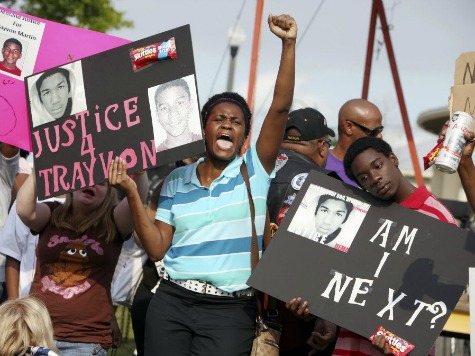(AP) Sanford police urge peace after Zimmerman verdict
By MIKE SCHNEIDER and KYLE HIGHTOWER
Associated Press
SANFORD, Fla.
Law enforcement officials are asking residents of Sanford and surrounding areas to remain peaceful after a verdict is announced in the George Zimmerman trial.
The Sanford police chief and Seminole County Sheriff made their appeal Friday shortly after jurors began deliberating in Zimmerman’s second-degree murder trial.
Zimmerman says he shot 17-year-old Trayvon Martin in self-defense. Prosecutors say Zimmerman was a wannabe cop who took the law into his own hands after a rash of break-ins in his Sanford neighborhood.
Sanford Police Chief Cecil Smith says the city has evolved since tens of thousands protested last year after Martin was killed. Civil rights leaders came to Sanford to demonstrate when Zimmerman wasn’t immediately arrested.
THIS IS A BREAKING NEWS UPDATE. Check back soon for further information. AP’s earlier story is below.
George Zimmerman’s lawyers made one last attempt Friday to convince a jury the neighborhood watch volunteer shot 17-year-old Trayvon Martin in self-defense, saying the prosecution’s case for murder is built on “could’ve beens” and “maybes.”
The jury was expected to begin deliberations as early as Friday afternoon after receiving dueling portraits of Zimmerman: a wannabe cop who took the law into his own hands or a well-meaning volunteer who feared for his life in a struggle with the unarmed teenager who was slamming his head into concrete.
Attorney Mark O’Mara told jurors the burden was on prosecutors, and said they hadn’t proven Zimmerman’s guilt beyond a reasonable doubt.
Prosecutor John Guy followed with a rebuttal, accusing Zimmerman of telling “so many lies.” He said Martin’s last feeling was fear as Zimmerman followed him in a neighborhood on a rainy night Feb. 26, 2012.
One juror, a young woman, appeared to wipe away a tear as Guy said nothing would ever bring back Martin.
Guy said Zimmerman violated the cornerstone of neighborhood watch volunteer programs, which is to observe and report, not follow a suspect.
Zimmerman’s account of how he grabbed his gun from his holster at his waist as Martin straddled him is physically impossible, Guy said.
Because there were no eyewitnesses, the panel of six women will likely rely heavily on testimony _ which was often conflicting _ from police, neighbors, friends and family members. They will have to decide who the aggressor was and whether they can determine who was yelling for help on a 911 call that recorded the shooting.
Zimmerman, 29, is charged with second-degree murder, but the jury will also be allowed to consider manslaughter. Under Florida’s laws involving gun crimes, manslaughter could end up carrying a penalty as heavy as the one for second-degree murder: life in prison.
O’Mara dismissed the prosecution’s contention that Zimmerman was a “crazy guy” patrolling his townhome complex and “looking for people to harass” when he saw Martin, an unarmed black teenager. O’Mara also disputed prosecutors claim that Zimmerman snapped when he saw Martin because there had been a rash of break-ins in the neighborhood, mostly by young black men.
Zimmerman at no point showed ill will, hate or spite during his confrontation with Martin, which is what prosecutors must prove for second-degree murder, O’Mara said.
In contrast, prosecutors argued Zimmerman showed ill will when he whispered profanities to a police dispatcher over his cellphone while following Martin through the neighborhood. They said Zimmerman “profiled” the teenager as a criminal.
O’Mara also told jurors to ask themselves what Martin was doing during the four minutes from when he started running at the urging of a friend he was talking to on a cellphone to when he encountered Zimmerman. Martin was planning his attack instead of going back to the townhome where he was staying, O’Mara said. The defense attorney let four minutes of silence pass to emphasize the amount of time.
The defense attorney bolstered his arguments with a poster-board timeline of events, a power point-presentation showing witnesses who had testified and a computer-animated depiction of the fight based on Zimmerman’ account.
O’Mara placed two cardboard cut-outs of Zimmerman and Martin in front of jurors to show Martin was considerably taller than Zimmerman, although Zimmerman was much heavier. Later, he carried a block of concrete and put it in front of the jury box to show how it can be used as a weapon.
To invoke self-defense, Zimmerman only had to believe he was facing great bodily harm, O’Mara said. He asked jurors not to let their sympathies for Martin’s parents interfere with their decision.
Allowing the jurors to consider manslaughter could give those who aren’t convinced the shooting amounted to murder a way to hold Zimmerman responsible for the death of the unarmed teen.
To get a manslaughter conviction, prosecutors must show only that Zimmerman killed without lawful justification.
As the nation awaits a verdict in the trial, police and city leaders in Sanford and South Florida say they have taken precautionary steps for the possibility of mass protests or even civil unrest if Zimmerman, who identifies himself as Hispanic, is acquitted, particularly in African-American neighborhoods where passions run strongest over the case.
There were massive protests in Sanford and other cities across the country when authorities waited 44 days before arresting Zimmerman.
Guy said the case wasn’t about race.
___
Follow Kyle Hightower on Twitter at http://twitter.com/khightower.
Follow Mike Schneider on Twitter at http://twitter.com/MikeSchneiderAP.

COMMENTS
Please let us know if you're having issues with commenting.